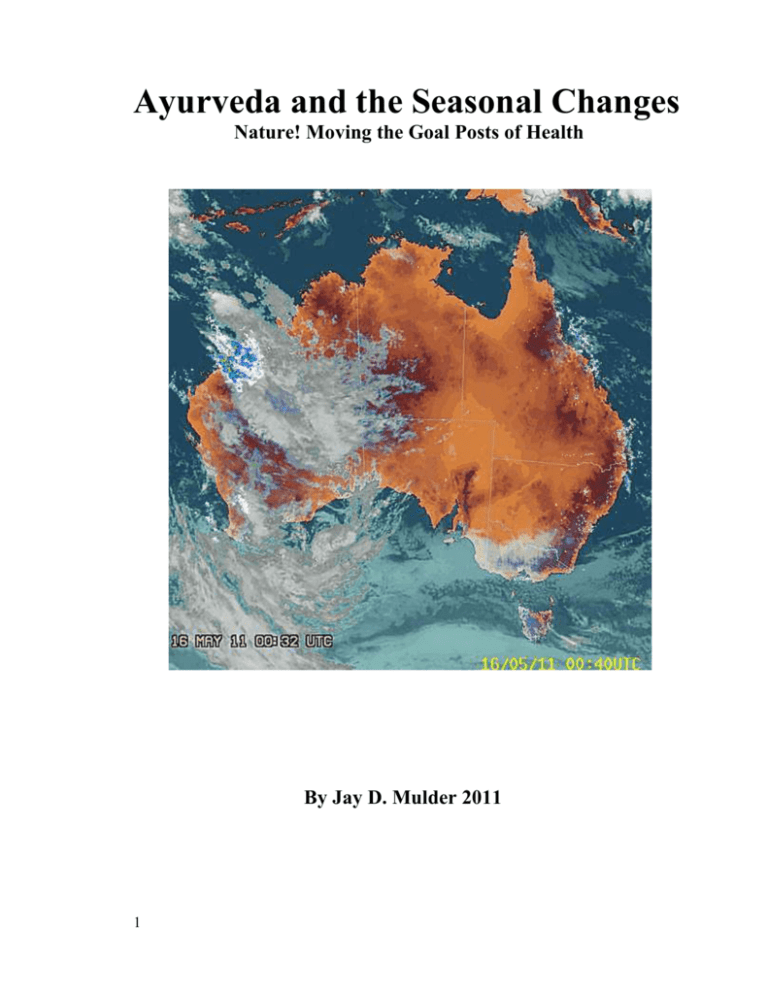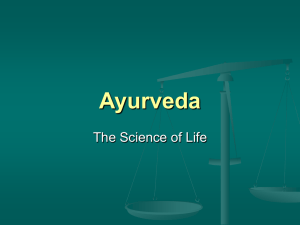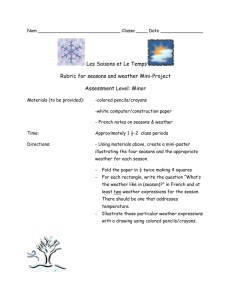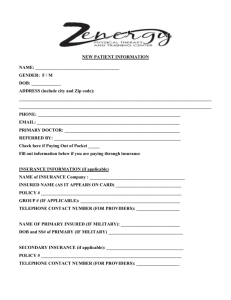The Seasons Moving - Eumundi Medicine Man
advertisement

Ayurveda and the Seasonal Changes Nature! Moving the Goal Posts of Health By Jay D. Mulder 2011 1 THE THIRD CAUSE OF DISEASE Nature - Moving the Goal Posts of Health Seasonal influence with climatic changes is the third cause of imbalance of the doshas. At change of season, nature shifts the point of balance, making it easy to over expose to heat, cold, moisture and wind, thus the doshas are easily disturbed and one becomes ill. It’s somewhat like moving the goal post in the middle of a game and throwing the match into confusion! You thought you had your health managed but nature adjusted, and good became bad. That item you performed in the summer which gave you vitality and strength now may knock you senseless in the cold season. For example; netti pot use, eating museli, bananas, yoghurt, excessive raw and cold foods or simply cold water in the cold season will augment cold and wet qualities and aggravate the doshas causing illness. Also excessive pungent, astringent and bitter foods in a dry hot mid-summer may cause an imbalance due to an inherent decreasing nature of those substances and the mid-summer season. Basically all life and time is controlled by the Sun, and there would be no juice to life without the Moon which is the counterpart of the Sun. The Sun energises while the moon nurtures, the sun draws moisture upwards, while the Moon redistributes that moisture downwards. After a sunny day the earth is parched, yet in the morning, dew covers the ground. This is compared to the harmony of the universal dualities yang and yin in Chinese philosophical medicine and the dosha theory of Vata? Pitta and Kapha of Ayurveda. Rain with winds come and go either giving new life or if ferocious destroying life. The seasons whether six in number like India or three, according to where you may live, vary, as they come and go. The morning sun increases life while the afternoon sun decreases life. 2 The seasons are nothing but the movement of the Sun and the Moon governing rain and wind with their energies. In other words, these are the movements of Vata, Pitta and Kapha respectively. The wind that ushers in change by its movements is known as Qi by Chinese medicine and Vata by Ayurveda. Caraka writes; ‘the world and the body are derived from the five elements, healthy life is dependent on the equilibrium of these elements’.1 ‘However the world is in constant flux therefore this mandates adaption to change as the essential condition of life.’ Caraka concludes, "Seasons come and go and signify changes in bodily strength." “The Moon gives moisture, the Sun dries and the air mixing with both gives life”.2 Susruta writes, ‘The rise and fall of the sap of life (rasa) which determine the various qualities of living forms, and the life and death of human beings no less, are brought about by time.’ Rasa and blood are nurtured by good digestion and diet. When rasa or plasma flows and are rich, the blood is equally nurtured, as is muscle, fat, bone, marrow and reproductive fluids. Naturally the decrease of rasa in the dry hot summer spells bodily weakness on all levels of the bodily tissue, dhatus. Decrease of rasa is called the procurement season culminating in the dry intense heat of summer and the increase of rasa or bestowal season culminates during the cold of winter when rasa generally reaches its maximum during the year. Seasons come and go and signify changes in bodily strength due to changes in bodily rasa. 1 2 M. S. Valiathan, The Legacy of Caraka, Chapter 4, Life in Accord with the Seasons. M. S. Valiathan, The Legacy of Susruta, Chapter11, Time, Seasons and the Human Body. 3 Movements from hot to cold, signify a gradual increase of bodily strength due to rasa peaking in mid cold season. As weather moves from cold to hot, strength is gradually diminished as rasa decreases, cumulating at the height of summer to its lowest level. Autumn to winter is generally a time of renewal with early autumn or late summer rains returning moisture and therefore strength to the world. Bodily rasa increases and therefore strength increases. On the opposite side rasa diminishes as the weather becomes warm and dry, moisture and therefore bodily rasa are lowest in the dry heat of midsummer. Therefore in dry intense heat of summer, lesser amount of food, mild exercise, minimum sex and light work are recommended. Sweet, cool and fatty foods are appropriate in reasonable portions because they have a cooling and moisturising nature. Susruta, "When the characteristics of the seasons such as heat, cold and wind with rain are excessive, deficient or out of turn, they are likely to perturb the three doshas in an individual."3 The seasons can go topsy-turvy at any moment, causing the doshas to be disturbed. However, generally it is Vata which becomes increased in winter, while Kapha increases in spring with Pitta dosha increasing in autumn. The changes in the doshas aggravated or augmented by improper diet (ahara) and lifestyle (vihara) are the general cause of illness at change of season. Movements of weather are constantly changing; seasons come and go, winters turn to spring then summer arrives. The wind and rains appear then disappear. The three doshas are affected either causing disequilibrium or equilibrium. Also each place on earth has a unique climate and seasons. What one does and does not do is also a healing modality! 3 M. S. Valiathan, The Legacy of Susruta, Chapter11, Time, Seasons and the Human Body p.97 4 In Australia seasons vary greatly from the tropics of Darwin to the subtropics of the South East Coast from the great inland deserts to Perth, then Melbourne with its bipolar weather and the windy island of Tasmania. An Ayurvedic seasonal philosophy requires an allinclusive logic to be applicable in a variety of environments. Therefore, we are proposing that the seasons be understood not in the limited or relative concepts of local names of seasons. Rather the seasons can be known by their energetic nature or gunas (qualities). These simple universal seasonal qualities are explained by Caraka and Susruta, such as hot moving to cold with wet and wind movements. This energetic seasonal concept gives a fresh understanding to the movement of the doshas. Naturally according to the Ayurvedic principles of Samanya or sameness, like increases like, so cold increases both Vata and Kapha. Vata has a quality of lightness, so naturally moving and rough wind augments Vata thus causing aggravation. Therefore Ayurveda recommends seasonal activities to help maintain doshic equilibrium during changes of weather. To repeat Caraka Muni on the concept of seasonal adaption, ‘However the world is in constant flux therefore this mandates adaption to change as the essential condition of life.’ Seasonal disturbance of the doshas according to Susruta and Caraka; 1.Vata is deranged in winter: when the season is intensely cold. 2. Pitta is aggravated in autumn: after the intense summer heat. 3. Kapha is accumulated in spring: after heavy eating of winter. Adaption is therefore the key to health during change of season! 5 1.Vata is deranged in winter: when the season is intensely cold. In cold weather the chill and winds retard the release of body heat, this centres Agni or digestive fire in the stomach. Heavy and large quantities of food become digestible. Also in the cold season, if the intake of food is insufficient, Agni consumes body liquids causing Vata disturbance which is common in cold weather. Oily, salty and sour foods which are heavy by nature can be taken, followed by wine or vinegar. Dairy products, oil and heavy foods as well as hot water do not harm in the cold season. Oil massage, warm clothes and shelter from weather extremes are recommended. Things to avoid are the Vata disturbing items such as cold drinks, insufficient food, eating excessive pungent, bitter and astringent foods. The digestive fire in winter is naturally good therefore excessive pungent is not required as this may aggravate Vata by over stimulating agni and causing dryness. Ayurveda is tridoshic, always attuned to equilibrium of the three doshas. Therefore, bitter, pungent and astringent tastes are generally consumed in balanced amounts and with harmonising regimes. It is difficult to find an Ayurvedic medicine with chilli, that is not to say the pungency of chilli cannot be used as a medicine, but that is to say chilli too easily aggravates Pitta and Vata. For pungency Ayurvedic formulas usually contain pippali and ginger which have a secondary sweet taste and therefore a cooling vipak or after digestive effect and therefore are less likely to aggravate Pitta. When using chilli in food it is recommended to fry the chilli in a little ghee, ghee being hot and wet helps to balance the hot, An aphorism is to an Ayurvedic practitioner as a seed is to a farmer.4 4 Gogte 6 sharp dryness of chilli. Sensitive Vata digestions can remove the chilli substance and utilize the remaining chilli ghee which has the mild energetics of the chilli. This can make the chilli very pleasant in small amounts even for a child. Pungent, bitter and astringent are all decreasing rough tastes, in other words the season from end of Winter culminating in midsummer is that of cool to intense heat, the gradual increase in heat dries the earth. That does not mean you should not have pungent, bitter and astringent foods but rather to be moderate during the decreasing solar phase of the season. Which is generally from late Autumn to mid-summer or from cool to extreme dry heat. The general Ayurvedic rule for good health is to daily experience the entire six tastes, in the correct proportions according to individual, dosha and time of year. Abhyanga or self massage with black sesame oil, nurtures the skin, making it warm and soft. Prevent the winter dryness of skin, by reducing the shower heat from boiling to pleasantly warm or just above body temperature. Have you ever thought that those shower saunas were the cause of your winter itchy dry skin? In warmer weather coconut oil may be superior for its slightly cooling qualities. Oiling the Body When windy conditions prevail dropping warm medicated oil in the ears, protects and cleanses. Nasya or oiling the nostrils with anuthailam maintains clear passages. Daily routines such as nasya, ear oiling and abhyanga or self massage are implemented for protection from cold and dryness. Mind controlled is a friend; same mind uncontrolled is an enemy!5 5 Bhagavad Gita 7 Taste (rasa), Gunas (qualities) and Vata Tastes that pacify Vata; sweet, salty and sour Tastes that aggravate Vata;bitter secondary, astringent &pungent Gunas that pacify Vata; are warm, moist, and heavy. Note; because sweet rasa is cooling and heavy (except honey) it is best to have sweet with warming spices like cardamom, cinnamon, ginger, pepper or pippali to aid a tridoshic or balanced aspect.. 2. Pitta is aggravated in Autumn: after the intense summer heat. In mid-summer the sharp rays of the sun rob the earth of moisture changing all substances. Cool, sweet, liquid foods like cucumber or watermelon or fatty foods like avocado and ghee are then indicated for a cooling energy. Intense physical exertion, wine, salty, sour, pungent and hot foods are best avoided. Sleep and exposure to moonlight is recommended as well as walking in the forest or lakes. Abstinence from sex is also recommended because of low strength. Low digestion in the summer season is due to the summer heat drawing bodily Pitta from the stomach to the outer body. The heat of summer accumulates and can travel to various channels, systems and organs in the body. Excess Pitta cannot be seen on an ultra sound or x-ray, but possibly may be picked up by thermoimaging. The accumulated heat of a tissue at the cellular level will be felt, subjectively with discomfort, pain, indigestion, constipation or diarrhea. If the slight symptoms of doshic imbalance are ignored in the beginning the accumulated heat may increase further over time manifesting as a tissue change and a diagnosable disease. Because Ayurveda is concerned with the three doshas as the basis of health and therefore disease, the elemental doshas are the foundation of life. Ayurveda is naturally authentic preventative medicine. Life can be said to be a product of rasa! 8 What a warped society we live in when an increase in the number of hospital beds and rooms is considered primary preventative care? Or throwing a few billion dollars here and there is considered preventative care! Rather to balance the doshas according to individual, season, time and place should be the foundation of preventative medicine. When the doshas are imbalanced for a long time, local tissue is aggravated and may undergo change (histology). Therefore some diseases at the later stages becomes difficult to cure or is incurable. If the original source of disease, the five imbalanced universal elements, functioning as water, fire and air can be changed into harmony, prevention becomes a reality. Early patterns of disturbed energetic such as cold, hot, dry, wet, light, heavy, rough, sharp, dull, slow need to be understood by the alert practitioner as early as possible. By understanding Ayurveda; The qualities that disturbed the equilibrium of the body are harmonized before disharmony is felt. In the autumn when Pitta heat manifests one can purge the heat from the bowels with suitable Ayurvedic formulas like thrivruth, adipathy or triphala. This is an excellent time for some bitter cooling foods like brussels sprouts, cucumber or sweet liver herbs like guduchi. Ayurveda has formulated hundreds of preparations for specific effect on individual dosha, tissue, waste products, channels, (organs, systems.) Which house various vibrational energetics which may be appropriate as seasons come and go and may effect different individuals. Vasa-gulochyadi is a terrible tasting bitter herbal blend which pacifies liver heat. Good and bad move with the seasons, swirling in the breeze! 9 Tastes that pacify Pitta are sweet except honeybitter& astringent Tastes that aggravate Pitta are; Pungent (except small amounts of pippali), Sour except amalaki and a small amounts of lime, Salty also aggravates Pitta except Ayurvedic rock salt, saindhaiva. The Guna that pacifies Pitta is cooling in nature. Exceptions to the pungent taste aggravating heat are pippali, long pepper and fresh ginger in small amounts. This is because of the sweet after taste. Cooling Herbs, Amalaki in Chyavanapras. Guduchi in Amrutharistham 3. Kapha is accumulated in spring: after heavy eating of winter. The dampness and congestion (ama) of winter accumulates in the channels and tissues as the weather warms. In early Spring Ama and Kapha liquify and congest the body. Sweet tastes except for honey greatly aggravate ama accumulation at this time of year. To clear congestion simply avoid all sweet items except honey. If you do eat something sweet like sweet potatoes, sprinkle over pepper, salt and garam masala to give a warming clearing digestive energy. Heavy items like bananas, nuts, cold and raw food, especially yoghurt all greatly increase ama. In early Spring the accumulation of that heavy winter eating, of stocking up on warm grounding foods manifests as ama or a sticky substance blocking the channels. This is the example of the goodness of one season manifesting as the curse of the next season. Ama is often the source of chills and fevers and the source of flu and cold like symptoms. Also bacteria and fungus are attracted to ama as a breeding ground. So moving the ama at the beginning of spring is an important annual ritual. Adjustment, ‘Satmya’, allows humans to comfortably live in incompatible circumstances! 10 Clearing Congestion of Winter Ama! Drinking hot water, assuring full bowel movements before breakfast, avoiding heavy foods like muesli, nuts, bananas, cheese, yoghurt, cold liquids and avoiding the sweet tastes except for a little honey, avoiding excess raw cold food, eating while still digesting the previous snack or meal, also raising digestion and cleansing the body is the theme. Fasting may be beneficial for Kapha individuals not recommended for Vata & Pitta pungent bitter and astringent herbs like the ama or mucus moving Pancakoolam powder is recommended. Indian long pepper of pancakoolam dissolves toxins and rekindles digestive fire while bitters tone digestion and cleanse the bowels and blood. Taste (rasa), Qualities (guna) and Kapha; Tastes that aggravate mucus and ama are; Sweet, except honey, Sour except lime, lemons and amalaki. Tastes that pacify Ama and Kapha are; Pungent, Bitter and Astringent Gunas that pacify Kapha are hot, light and drying. Note; Bitter herbs because of a powerful cooling energy generally require pungent herbs mixed with them to give a Kapha and Vata balancing energy. Ayurveda has many yagams or formulas for this purpose of balance or tridosha. The study of dravyagunavijnana of applying the healing energies of substances is a detailed study requiring years of study and application, do not take the above in black and white. This is only to give the student a simple glance at the concepts, of dravya-substances and guna-qualities. In conclusion Susruta states; Therefore it is prudent to check and treat, accumulated ama in the spring, aggravated Pitta in autumn and deranged Vata in the cold season. Generally household dravyaguna or knowledge of substances, was passed down from grandparents for the benefit of the family. 11 SEASONS ARE RELATIVE AND VARIGATED Everyone in the world will experience seasons according to their nature and geographic position. A person born in the snow will have a natural tolerance of cold more than an individual born on a tropical island. So the season may slightly vary according to our natures. A Pitta prakruti will enjoy the cooler weather by nature. Some places like Melbourne have four seasons in a day. Actually everywhere seems prone to great ‘anomalies’ in the weather. As we all experience, seasonal change within themselves, sometimes summer runs past and is hardly summer, sometimes the winters are greatly varied. Sometimes, a season surprises us with an enthusiastic entrance or a sudden departure. However, within these incredible variations are common energies, the movement of hot to cold and cold to hot, with changes of dry to wet, wet to dry and also the movements of wind and calm. It is these movements or changes which can push the doshas out of balance. To repeat Susruta and Caraka: "When the characteristics of the seasons such as heat, cold and wind with rain are excessive, deficient or out of turn, they are likely to perturb the three doshas in an individual." ‘However the world is in constant flux therefore this mandates adaption to change as the essential condition of life.’ Seasonal disturbance of the doshas according to Susruta and Caraka; 1.Vata is deranged in winter: when the season is intensely cold. 2. Pitta is aggravated in autumn: after the intense summer heat. 3. Kapha is accumulated in spring: after heavy eating of winter. A wise concept of the seasons, requires being as fixed, and also as changeable as the seasons! 12








